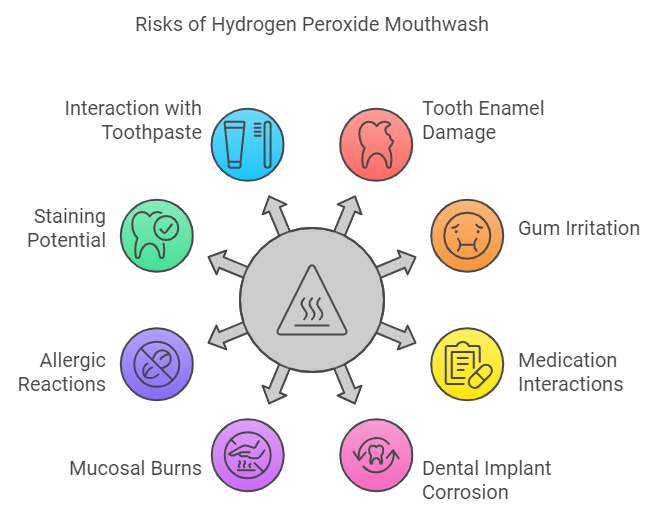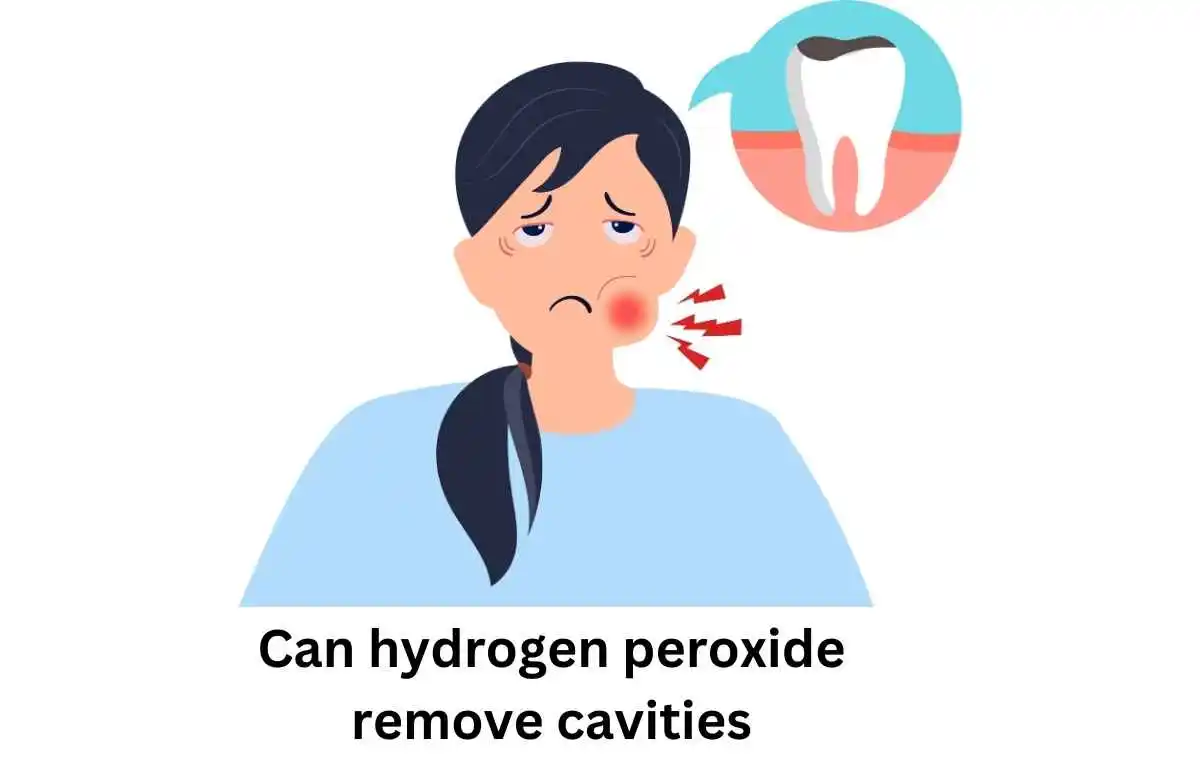Hydrogen peroxide has become a popular home remedy claimed to remove stubborn cavities without a trip to the dentist.
As an antiseptic regularly used for minor cuts or infections, some believe simply swishing a 3% hydrogen peroxide solution around the mouth can repair tooth decay from the inside out. But is there any science to back the cavity-healing powers of this common household ingredient? Let’s separate fact from fiction on this oral care hack.
The proposed mechanism is that hydrogen peroxide antibacterial properties can kill the plaque bacteria responsible for cavities. By reducing these acid-producing microbes, the theory goes it allows remineralization of enamel to naturally refill pinhole cavities. Some promoters even claim just a few daily rinses can fully undo damage from years of neglect. However, taking a closer look, what do carefully-controlled clinical studies on this remedy reveal?
While hydrogen peroxide may provide a mild cleansing effect and short-term reduction of oral microbes, research suggests any positive impacts on cavities are negligible at best. Remineralization requires sustained exposure to minerals like calcium and phosphate, yet hydrogen peroxide washes out within minutes of use.
Table of Contents
- The role of hydrogen peroxide in oral care
- Can hydrogen peroxide remove cavities
- Benefits of using hydrogen peroxide as mouthwash
- Risks of using hydrogen peroxide as mouthwash
- Key takeaways
The role of hydrogen peroxide in oral care
It can play an important role in oral hygiene when used as a mouthwash or whitening agent. As a mild antiseptic, peroxide works by releasing oxygen radicals that eliminate bacteria in the mouth linked to plaque, gingivitis and early stage caries.
Used as a daily rinse, it can reduce these microbes and thereby help prevent new cavities from forming. Peroxide solutions are also effective for naturally bleaching teeth, breaking down surface stains on enamel and between teeth. When applied by a dentist in higher concentrations, it can professional whiten teeth several shades. As an oral care ingredient, hydrogen peroxide functions as both an antibacterial and brightening agent to maintain good oral health and hygiene.
Can hydrogen peroxide remove cavities
Many people wonder can hydrogen peroxide remove cavities on its own. While it has some antimicrobial properties, the answer is that it cannot fully remove established cavities without dental treatment.
While hydrogen peroxide is an active oral antiseptic as a mouthwash or whitening agent, it functions topically on the teeth’ surfaces. It works by releasing oxygen to kill certain bacteria in the mouth. However, it does not have an abrasive quality needed to cut into and extract decayed material from an existing cavity.
At best, hydrogen peroxide may help bleach stains on cavity walls. But it cannot penetrate deep within the tooth structure to surgically remove all demineralized portions. Only a dentist, using drill tools and fillings, can completely clean out and close the cavity void.
Therefore, while hydrogen peroxide supports oral hygiene prevention, it is not a replacement for professional treatment once a cavity has formed in the tooth’s inner layers. Dental care is required to fully repair such damage from decay.
Benefits of using hydrogen peroxide as mouthwash
As anatural mouthwash, it exhibits antimicrobial might via its reactive molecules that demolish both plaque-causing pathogens and those producing stinky halitosis.
With hydrogen peroxide in your corner, cavity-breeding bacteria don’t stand a ghost of a chance. It also works diligently to vanquish existing dental dross while simultaneously warding off fresh deposits. Further showing its superpowers, this inexpensive ingredient doubles as a teeth-brightening agent that lifts surface stains from your pearly whites.
What truly sets hydrogen peroxide apart though is its potent yet placid properties – it dispatches microbial foes without causing any distress to delicate oral tissues. Simply put, a quick daily rinse leverages its antimicrobial aptitude to promote holistic dental wellness in a manner both cost-effective and safe.
Indeed, hydrogen peroxide deserves star billing as a natural mouthwash hero that gets the job done with minimal effort!
Risks of using hydrogen peroxide as mouthwash

Tooth Enamel Damage
High concentrations have potential to prematurely whiten or dehydrate enamel over years of frequent use through its bleaching mechanism. Low concentrations under 3% pose low risk if swished thoroughly and spit out.
Gum Irritation
Sensitive individuals may experience gum tingling, burn or inflammation from peroxide contact depending on solution strength. Risk increases if overtly vigorous swishing brings excess into direct gum exposure.
Interactions with Medications
Peroxide can neutralize or accelerate breakdown of some medications if rinses are done too closely before or after. This includes antibiotics and blood thinners. It’s best to wait 30-60 mins before or after taking oral medications to rinse.
Dental Implant Corrosion
Implants contain metals that can theoretically oxidize or corrode more quickly from frequent peroxide exposures in high doses. Manufacturers advise protecting dental work during rinses or using a specially formulated implant-safe mouthwash instead.
Mucosal Burns
Rare but possible with improper use of concentrated solutions, especially if held in mouth too long without spitting versus brisk rinsing. Can burn inside cheeks or lips. Always follow product label instructions and add extra water for dilution if irritation occurs.
Allergic Reactions
True allergies to peroxide are uncommon but possible, with symptoms like swelling or hives on contact. A patch test can confirm for sensitivity. If rinsing induces any strange or painful reaction, discontinue use.
Peroxide is considered generally safe when used as directed; however, taking extra care to avoid over-application helps minimize any potential risks. Dilution is especially important for those with dental work or sensitive tissues. Consulting a dentist is also advised for implementation guidance suited to individual needs. Overall, peroxide mouthwashes provide benefits but require mindfulness in application.
Staining Potential
Surfaces stained by foods like berries or turmeric can potentially set further when blended with peroxide due to bleaching mechanism. Rinsing for a minute with water after eating is prudent or save mouthwash for later use to avoid fixing stains.
Interaction with Toothpaste
The active bleaching from peroxide may reduce effectiveness of antibacterial ingredients in regular toothpaste if used too closely one after another. Space mouthwash rinses by at least 30 minutes after toothbrushing for maximum oral care impact.
Key takeaways
- It’s an effective natural antiseptic . releases oxygen radicals that kill harmful plaque bacteria.
- Helps prevent cavities by reducing levels of decay. causing microbes in the mouth.
- Gently whitens teeth over time by breaking down surface stains, with no abrasion.
- Supports gum health by lowering inflammation from less plaque buildup.
- When used diluted as directed, it’s generally safe to use as a daily mouth rinse for oral hygiene support.

